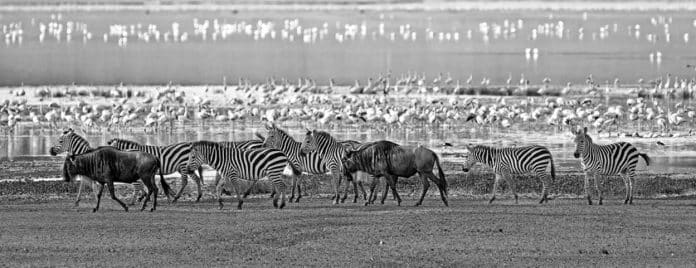A Quick Walkthrough – Discover Lake Manyara National Park Tanzania
Where is Lake Manyara National Park?
Lake Manyara National Park is a preserved zone in Tanzania’s Manyara and Arusha regions, located amidst the Great East African Rift Valley and Lake
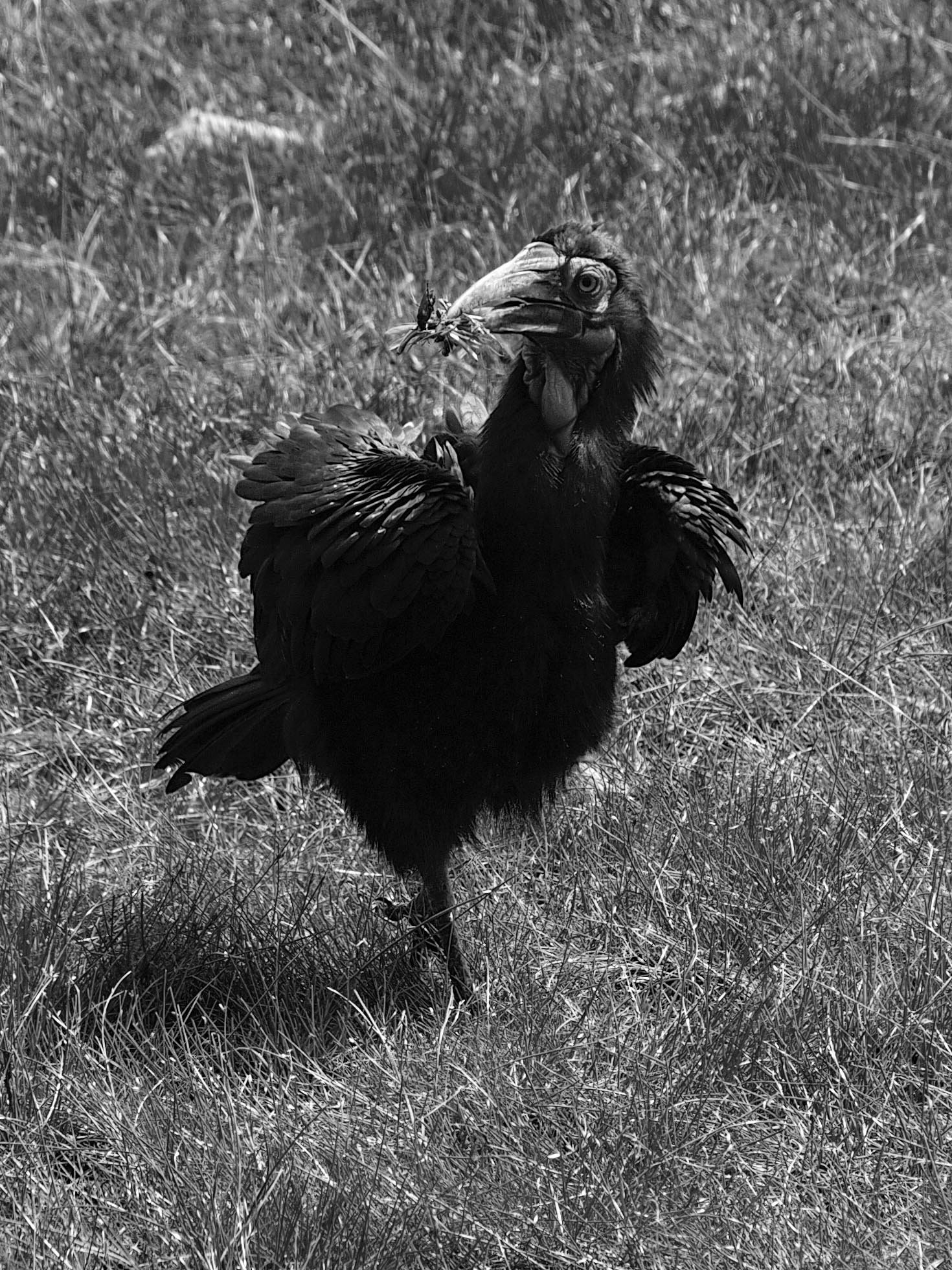
Manyara. National Parks Authority of Tanzania (TANAPA) manages this park covering 325 kilometres squared (125 square miles) leaving out around 230 kilometres squared (89 square miles) lake surface. Above 350 species of birds have been spotted by the lake.
Lake Manyara National Park Background
From the 1920s, the area of Lake Manyara was for sports hunting. By 1957, a game sanctuary was created. By 1960, the sanctuary was made a National Park and by 1974, the southern end was added around 550 hectares (1,400 acre). The biggest area of the Lake Manyara National Park is a tight strip in the middle of Lake Manyara, a soda lake, in the east and the Gregory Rift wall in the west.
The Lake Manyara National Park only includes the lake’s northwestern part, around 200 kilometres squared (77 square miles). It belongs to a larger Biosphere Reserve of Lake Manyara, created by UNESCO in 1981 to be part of its programme about Man and the Biosphere.
Lake Manyara National Park Weather

The rainy seasons are two- the “long rains” between March and May and “short rains” between November and December. April is the wettest month having the most rainfall at 161 milimetres (6.3 inches) and also with more 19 days with rain. July, August plus September are the driest months receiving the least rainfall at 1 milimetres (0.039 inches).
September at the Lake Manyara National Park also records the least average number of 2 days with rain. January, February and March are the warmest months having the most average peak temperature, measuring 30 °Celsius or86 °Fahrenheit. June and July have the least average peak temperature are, measuring 25 °Celsius or 77 °Fahrenheit. The nearby highlands seem to be cooler with additional rainfall.
Tanzania Lake Manyara National Park Location
Lake Manyara National Park is found 126 kilometres (78 miles) southwestern Arusha and is accessible in 1 ½ hour by car. The park is also reachable from Babati, Manyara Region’s capital. Lake Manyara Airport is close. In the south is the 35,399-hectare Marang Forest Reserve located on the escarpment beyond the park. In the east is Kwa Kuchinja Wildlife Migration passage, which allows wildlife migration from the adjacent Tarangire National Park in the southeast, Lake Manyara in the west, and the Engaruka Basin in the north. In the Kwa Kuchinja passage are various villages.
Away from the lake and beyond village land is Manyara Ranch, a 45,000-acre former livestock ranch, under the management of the Tanzania Land Conservation Trust from 2001 and an essential portion of the corridor supporting wildlife movement between Lake Manyara and Tarangire game parks. Lake Manyara National Park belongs to the lake’s Biosphere Reserve. The lake with parts in and out of the park
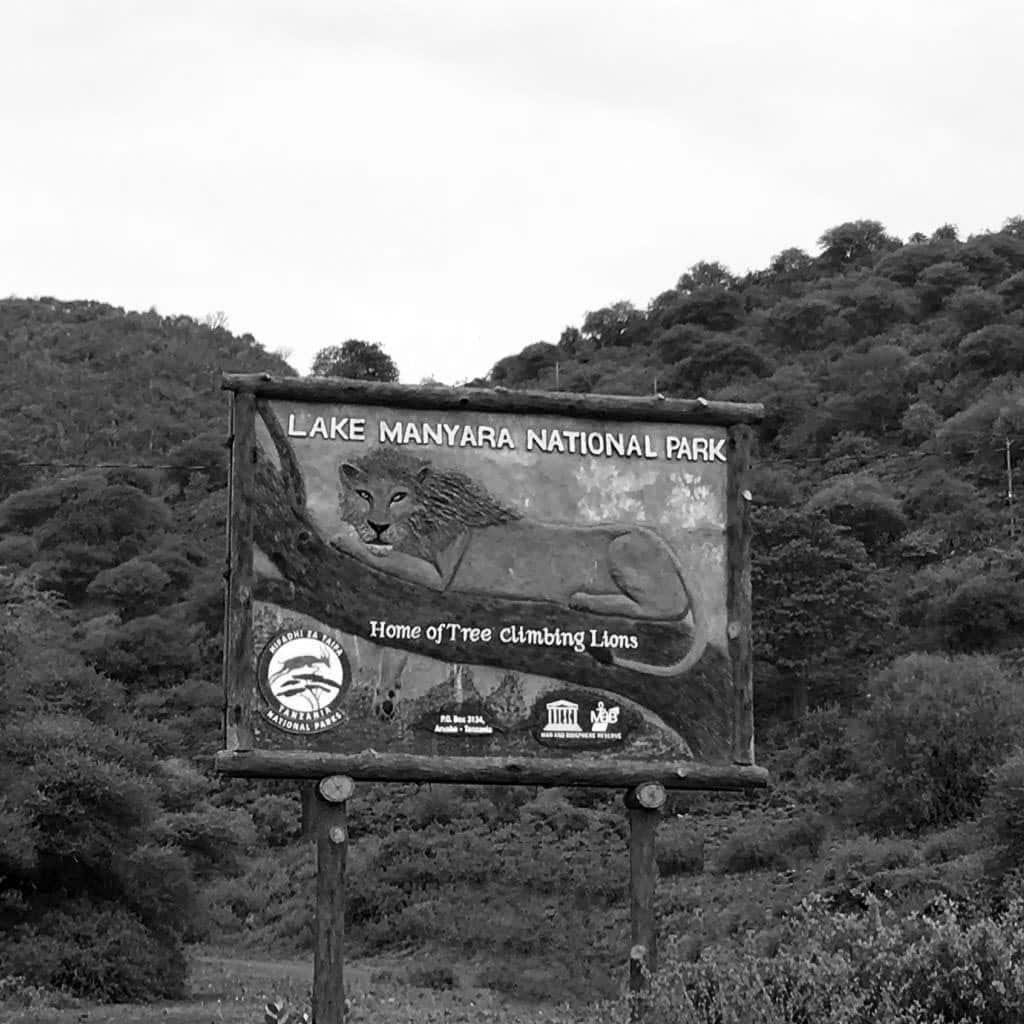
together with Marang Forest Reserve in the nearby highlands, are part of the Lake Manyara essential aviary area.
Topography of the Lake Manyara National Park and Surrounding Areas
Lake Manyara is a surface alkaline lake at an elevation of 960 metres (3,150 feet), created in a Rift Valley depression. The lake has a maximum depth of 10 feet (3.0 metres) when full and forms two-thirds of the park. Water doesn’t flow from the lake but comes from underground springs including various permanent streams draining nearby Ngorongoro Highlands. The depth of the lake and the coverage area fluctuate significantly.
During the driest periods, the lake’s surface area shrinks since the water evaporates and sometimes the lake dries up completely. In 2010, the lake was discovered to be 0.81 metres (2 feet 8 inches deep by a bathymetry survey, with a maximum depth at around 1.18 metres (3 feet 10 inches). During its peak in the rainy season, the width of the lake is 40 kilometres (25 miles) by 15 kilometres (9.3 miles) with the utmost deepness at 3.7 miles (12 feet).
Apart from the lake are saline flats (that extend during the dry season when the lake’s surface area shrinks), a floodplain filled with grass and expansive marshlands. A tall forest exists close to the park gate, maintained by groundwater, filled with mahogany and evergreen fig trees. By Lake Manyara National Park’s west side, rises steeply on the rift valley wall’s rocky escarpment from 1,219–1,829 metre (3,999–6,001 feet). Huge African baobab (Adansonia digitata) trees are dispersed on the slopes. Dense acacia woodland grows in a narrow zone at the rift wall base, on materials eroded down the face.
Additional features found in the surroundings of the Lake Manyara National Park include a hippo pool at the lake’s north end including two hot springs, with one around the middle of the park and another around the southern edge. There’s a hot spring on Lake Manyara’s western shores known as Maji Moto. This 60 °C geothermal feature resulted from underground water which passes through the rift valleys’ hot volcanic rocks.
Lake Manyara National Park Wildlife
Flora
Lake Manyara National Park has diverse vegetation, with more than 670 flowering plants and species of fern documented. Many are common species; a few species are rare or indigenous.
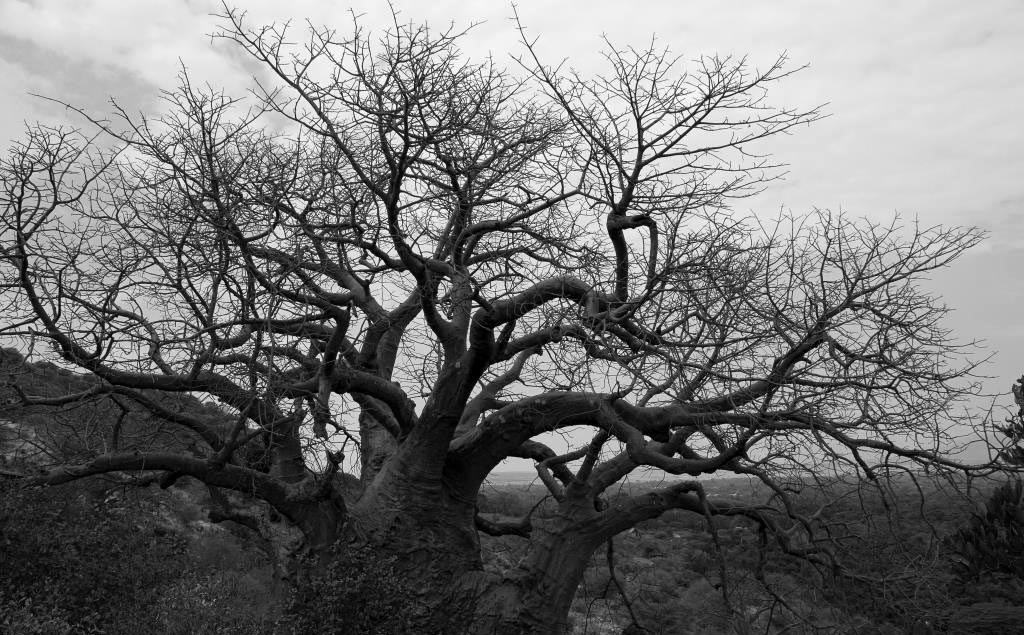
The Lake Manyara National Park has a varied diversity of habitats. Streams flowing from the escarpment plus perennial springs below the rift wall maintain tall, evergreen underground water forests filled by Trichilia roka with sycamore fig (Ficus sycomorus), forest toadtree (Tabernaemontana ventricosa), broadleaved Croton (Croton macrostachyus), and quinine tree (Rauvolfia caffra). Gorges have denser forests, alongside the edge of streams including in zones where springs come from. Thick stands of palm Phoenix reclinata and yellow fever trees (Acacia xanthophloea) grow at the groundwater forest edge.
The lake’s western shore has woodlands filled with Commiphora and Acacia species also sustained by underground water. Trees have irregular spacing; seepage zones are denser and beside drainage channels. Acacia tortilis is the dominating tree that grows to around 10 metre tall having a flat-top canopy. Understory shrub layer is diverse and patchy.
Extensive swamps have developed where the Simba River with its tributaries flow to Lake Manyara’s northern end and tiny swamps have developed elsewhere, related with the small rivers flowing from the rift valley walls. Some aquatic species have been recorded, including extensive mats of water lettuce (Pistia stratiotes) and two water lily (Nymphaea caerulea and N.lotus) species.
Cattails (Typha sp.) developed pure stands north of the swamps plus various species of Cyperus found near the swamps’ edges. Cyperus immensus develops dense clumps in locations flooded by freshwater. Cyperus laevigatus is popular alongside the lakeshore in locations with a high salty water table, in locations of shallow lagoons encircled behind sand ridges plus bordering river deltas.
Grass plains are filled with Cynodon dactylon in dry situations, or by Sporobolus spicatus, usually in relation with Sporobolus consimilis on the salty lake flats. Dominant on the exposed lakebed is Sporobolus spicatus and can be extremely extensive when lake levels become low, getting confined to a tight zone over the high water mark during high lake levels. Outside the Lake Manyara National Park are expansive locations of Psilolemma jaegeri plains side, alongside the lake’s eastern shore. Flora on the ridge is defined by African baobab trees (Adansonia digitata) and Ruellia megachlamys.
Birds in Lake Manyara National Park
Lake Manyara National Park is famous for multitudes of flamingos which feed by the lake edge during the wet season. By 1991, there were about 1,900,000 vagrant Flamingoes (Phoeniconaias minor) that don’t breed plus 40,000 larger Flamingoes (Phoenicopterus roseus). The white pelican or Pelecanus onocrotalus can also be seen in huge numbers (approximated to be 200,000 by 1991) plus in total there has been approximately 1,000,000 to 2,499,999 water birds, although, just 78,320 were estimated by 1994.
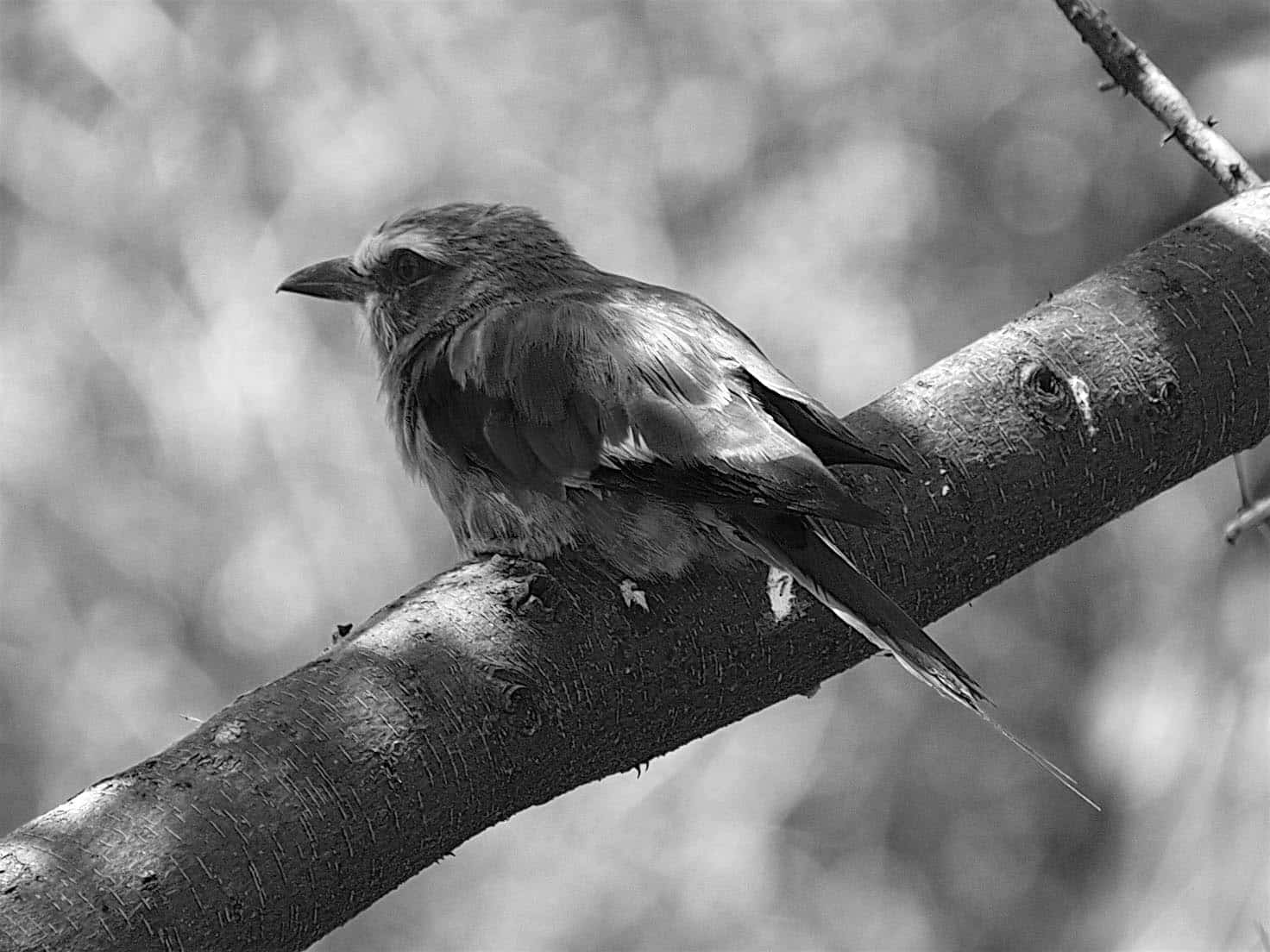
The underground water forest in the lake’s northern part, and with the biggest part at Lake Manyara National Park having a popular breeding ground for multitudes of yellowbilled stork or Mycteria ibis, pink-backed pelican (Pelecanus rufescens) including a few grey heron (Ardea cinerea) and marabou stork (Leptoptilos crumeniferus). More than 40 preying bird species are recorded, such as Ayre’s hawk eagle (Hieraaetus ayresii) and palmnut vulture or Gypohierax angolensis. Altogether, above 390 bird species have been recorded in the park, however, flamingos plus more water birds often in a few numbers during the dry season.
Lake Manyara National Park Animals
Herds of large migrant mammals which are concentrated mainly in Tarangire Game Park, however, move through Lake Manyara National Park include zebra, Thomson’s gazelle, wildebeest, Grant’s gazelle and zebra. Large populations of wildebeest including more animals in the plains from Mto wa Mbu wildlife managed area come into the park northwards for short sessions.
Exclusively, wildebeests feed on alkaline grasslands surrounding the lake, while figures sour during a dry season, reducing to a few resident groups during the wet period. Herbivores of Lake Manyara National Park include bushbuck, zebra, waterbuck, Thomson’s gazelle, Grant’s gazelle, impala, Cape buffalo, giraffe, hippopotamus, elephant, warthog, and baboon.
Research during the 1980s, found the area to be among those with Africa’s biggest wildlife biomass, however elephant figures had reduced by 75% from 1985 to 1991 resulting from poaching, with figures growing again to about 200 by 1996. The lake was also popular for its big population of black rhinos, however, there were none by 1996.
Likewise, reedbuck were around by 1984, however, none were discovered during a census in 1996. Predators of Lake Manyara National Park include African wildcat, lion, bateared fox, leopard, spotted hyena, honey badger, black-backed jackal, serval, African civet, various mongoose species and genet (Genetta) species. African golden cat and Cheetah are observed sometimes.
Lake Manyara National Park Fish
Oreochromis amphimelas, an endangered fish species from the cichlid family is native to Lake Manyara. It is indigenous to Tanzania but also inhabits a few additional saline lakes having closed basins. There’s no exploitation in the Lake Manyara areas, in the Lake Manyara National Park as well as the preserved park areas offer essential seed stock for replenishing fished populations.
Lake Manyara National Park Butterflies
More than 180 butterfly species have been recorded in the Lake Manyara National Park.
Lake Manyara National Park Safari and Frequently Asked Questions
The following is a number of things and Lake Manyara National Park facts one should consider and explore if planning to visit Lake Manyara National Park:
- Best time to visit Lake Manyara National Park – From the end of June all the way to the month of October. This period is the driest, situation that forces wildlife to concentrate on water sources around the park making a perfect opportunity for sightseeing.
- Lake Manyara National Park hotels – There are numerous hotels in Lake Manyara National Park, but we highly recommend the following because of the popularity and experiences most people have had when looking for Lake Manyara National Park accommodation options:
- Lake Manyara Tree Lodge Lake Manyara National Park Tanzania – https://www.andbeyond.com/our-lodges/africa/tanzania/lake-manyara-national-park/andbeyond-lake-manyara-tree-lodge/
-
Tloma lodge lake Manyara National Park – https://twctanzania.com/accommodation/tloma-lodge/
- Tarangire National Park or Lake Manyara comparison:
Both parks are in size smaller when compared to other game reserves in the country’s northern side. Tarangire National Park in square kilometers is approximately 2,850 while Lake Manyara National Park is only 325.
Another difference is the fact that Manyara National Park has a lake and Tarangire does not. But on the other end, when it comes to viewing animals Manyara is the go to place during the driest season of the year as animals are usually drawn to the lake to fetch some water. Meanwhile, Tarangire is the best throughout the year in terms of sightseeing animals particularly elphants as the park has a river which is its main center of attraction.
There are many other differences and similarities, but if budget and time allows, you should go to both as each park has its own uniqueness.
- Distances from Major Cities and Destinations:
- Distance from Arusha to Lake Manyara National Park – Approximately 2 hours and 26 minutes in terms of time. Then, 124.7 kilometers if driving through A104 and B144
- Distance from Lake Manyara to Serengeti National Park – 2 hr 57 min (132.0 km) via B144
- Distance from Tarangire National Park to Lake Manyara – 2 hr 38 min (120.7 km) via B144
- Lake Manyara National Park fees:
- Lake Manyara National Park entry fee for non citizens – Kids do pay about $17.70USD, while adults pay $53USD approximately
- Lake Manyara National Park entrance fee for Tanzanians – Adults pay about 11,800 Tanzanian shillings, and kids below age 16 years pay 2,360 Tanzanian shillings (these prices are as of year 2022).
- Lake Manyara National Park full day tours with lunch – Expedia has a number options for you to explore.
- Lake Manyara National Park reviews – The best place to get credible reviews from other tourists who have actually already visited the park would be the Lake Manyara National Park TripAdvisor page.
- Lake Manyara National Park activities:
-
- Lake Manyara National Park zipline – https://tanzaniazipline.com/
Lake Manyara National Park Map
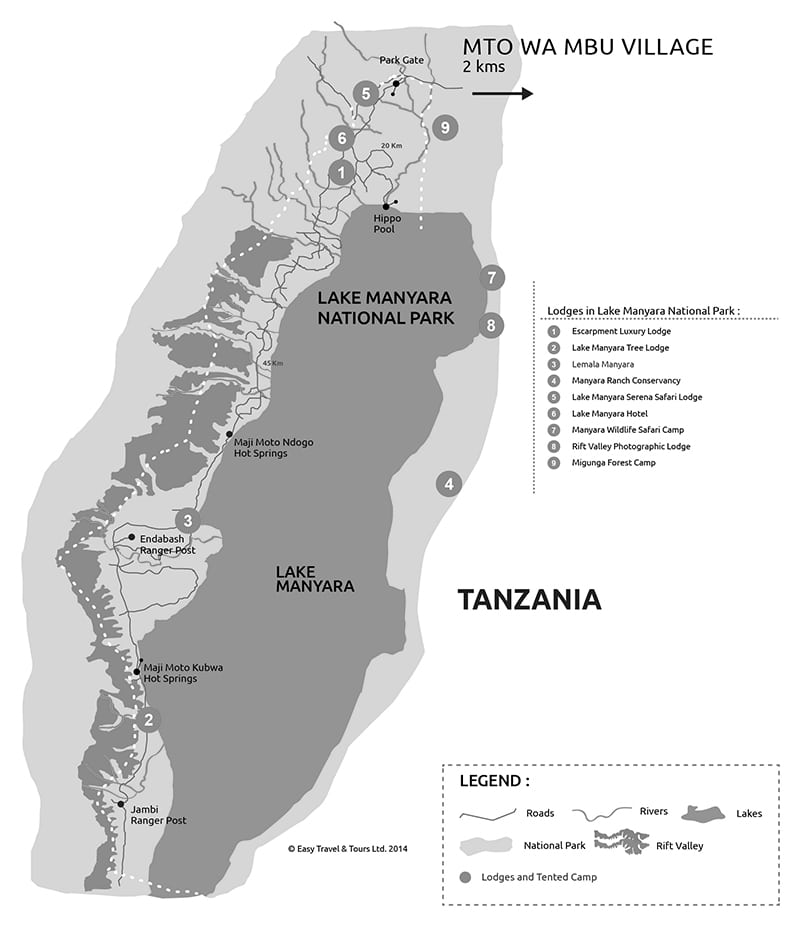
For more articles related to Wildlife Parks in Tanzania, click here!

























